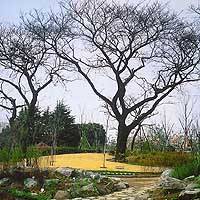After a cool March, the first warm days of spring are working their magic, and people are eagerly waiting for cherry trees to fill with blossoms.
But why wait to enjoy spring-flowering trees? Magnolias, which keep their buds under wraps through the cold weather, are now ready for a noble display of their blooms. And why limit your magnolia palette to shades of white? Last weekend I went to Keio Floral Garden "Ange" and found an impressive collection of 200 magnolia trees -- 30 different types -- with flower colors including pale pink, wine red and the most unusual of all -- the clear-yellow Japanese "Kinju" hybrid, which blooms mid-April. Although many were still in bud, this week's warm weather will encourage many more to open.
Besides, trees on the brink of flowering are as beautiful as birds poised for flight. The tall magnolia "Iolanthe" from New Zealand, for example, was a lovely sight, its bare, silvery branches bearing large, deep-pink buds full of the promise of spring.
"Ange" is a rather unusual garden, being an interesting mixture of old and new, East and West. It started life as a traditional Japanese water garden, with a fine display of irises in June. But, as landscape designer Masako Yamazaki explained, "Iris gardens need a lot of attention, so 10 years ago the garden was closed and began turning into a wilderness. A few years ago Masayuki Saigusa, the president of Keio Electric Railway, decided to renew the garden, but he wanted something quite different. I thought about magnolias, because although Japanese people know our native kobushi trees, there are many magnolias from around the world we don't know so well."
The new garden opened on March 29, 2002, and as well as exotic plants it offers a surprising range of features from Western gardens. The magnolia trees, for example, are scattered near a lawn and are under-planted with spring bulbs such as the fragrant narcissus and flowering hellebores (so-called Christmas roses).
Surprising harmony
There is also a walled kitchen garden, a rose garden, a herbaceous border, a rockery and a naturalistic stream. Just now, pussy willows are flowering by the water as well as clouds of fragrant, pink-petaled spirea ( benibana yukiya- nagi ). With its garden shop, talks and workshops, "Ange" reflects Japan's current "gardening boom," and the widespread interest in English or Western-style gardens.
Of course, the danger of packing so much into a relatively small area is that you end up with a garden of bits and pieces. However, Yamazaki has achieved a surprising degree of harmony in her new design while, at the same time, preserving some of the best features of the old garden.
There is a small path through the new rockery, for example, which leads to an old mound topped by two magnificent somei yoshino cherry blossom trees. As she says, "It would have been a terrible waste to lose old trees such as those." However, many other trees with a distinctly Japanese flavor, such as the ume (plum) trees, were moved to Keio's other garden, the traditional "Mogusa-en" in Hino (near Tama Zoo). This made space for more Western features, such as the wooden-decked terrace, which is a pleasant place for a picnic or even a cup of magnolia tea from the cafe.
Naturally, the garden is still very young, but as the overall design is still clear to see, it is a good source of ideas for home gardeners. I particularly liked the kitchen garden, surrounded by a brick wall that protects the plants from wind and retains warmth. Here the vegetables were emerging in delicious patches of color: sharp, steely-blue artichoke leaves contrasting with dusky-purple cabbages. Climbers such as Clematis montana are being trained to grow against the wall, and in the center of one bed is a small peach tree that will look like a little ballerina in a few week's time. Woven baskets are used to protect tender plants such as miniature carrots and giant purple-flowered onions from birds. These simple shapes and natural materials are very attractive. Similarly, the terracotta planters flanking a white bench make the spot more inviting, and it was a pleasant surprise to see them planted with ornamental radishes and so on rather than the usual pansies.
In fact, all the planters have attractive color combinations. Those near the entrance, for example, are a delicate combination of pink and white jasmine, blue scabious and pale-pink marguerites.
As Yamazaki says, "The garden will be mature in another two or three years. That might sound quick, compared to an English garden, but here we have more sunshine and rain, and plants, like weeds, grow much more quickly in Japan!"
And if you lose your heart to the magnolias, and would like one for a small garden, she recommends the star-shaped "King Rose" or one of the dainty "Girl" varieties. "They have lots of flowers, they don't grow too tall and don't need much attention." What more could anyone ask?





















With your current subscription plan you can comment on stories. However, before writing your first comment, please create a display name in the Profile section of your subscriber account page.